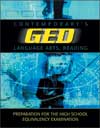|
 |  Contemporary's GED Language Arts, Reading John M. Reier
Prose Fiction
Chapter OutlineStudy the chapter outline below. Use the page numbers below each topic to refer to the corresponding section in Contemporary's GED Language Arts, Reading. When you are finished, go to the Flashcards or choose a different activity or chapter from the menu on the left.
Prose Fiction
(See 165)
Prose fiction consists of written works in paragraph form that deal with imaginary events, places, and characters: |
 |  |  | Setting
(See pages 166–172)
The setting of a work of prose fiction consists of three parts: - Place—the location or geographical area where the action occurs
- Time—the time of day, season, or historical period when the action occurs
- Atmosphere—the emotions associated with the story’s physical environment
The setting is either directly stated by the author, or it can be inferred by the reader. |
 |  |  | Point of View
(See pages 176–179)
The reader sees the events of a story through the eyes of the narrator—the person who tells the story. The narrator’s explanations and interpretations of the events represent the story’s point of view.
There are two main types of narrator:
- An outside narrator does not participate in the conflict of the story and is not a character in the story.
- A character narrator participates in the action of the story, and the reader witnesses the events through his or her eyes.
|
 |  |  | Figurative Language
(See pages 193–196)
- A simile is a comparison using the word like or a
- A metaphor is an implied comparison in which the writer states that something is something else.
|
 |  |  | Theme
(See pages 197–211)
The theme is the underlying meaning of a story: - beliefs and opinions about life
- attitudes toward political or social issues
- perceptions about human nature and relationships
The theme of a story is usually implied throughout the story, not stated directly. |
|
|



 2002 McGraw-Hill Higher Education
2002 McGraw-Hill Higher Education